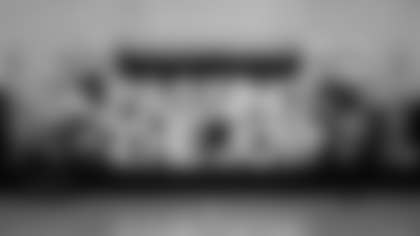In 1995, the Bucs thought it was worth two second-round picks to move up and get LB Derrick Brooks
In a recent bit of analysis for NFL.com, former Dallas Cowboys personnel man Gil Brandt revealed a chart used by one team to evaluate the equity of draft-pick trades (see the NFL.com links in the right column).
The chart uses assigned point values to each pick in each round, starting with 3,000 points for the first overall pick to two for the last overall pick. Add up the point values for the picks on each side of a proposed deal and – if you believe the system – you can tell which team is getting more value overall.
This is, of course, a system one would use before making a deal. Analyzing an actual deal a few years after it went down is obviously a lot easier. Brandt uses the point system to come up with almost equal values in the New York Giants-San Diego deal that kicked off last year's draft. However, if either Eli Manning or Philip Rivers proves to be a much better quarterback than the other, and the extra picks San Diego received amount to little, will we feel the same way in 2010?
The Tampa Bay Buccaneers, who own the fifth pick in a 2005 draft that has been mostly resistant to a consensus opinion on the top prospects, might have some interest in a system like the one Brandt describes. Most analysts believe the teams at the top of the draft will have difficulty finding potential trade partners this year; still, it's entertaining to consider what a fair trade would be.
Using the system described by Brandt, what would it take to make a trade from the fifth spot down to the 20th a fair one for the Buccaneers? Here's one answer: That 20th overall pick plus the eighth and 23rd picks in the second round. Here's another: The 20th overall pick and the eighth pick in the second round plus the 14th and 24th picks in the third round. Of course, we're not even considering whether the team with the 20th pick would even have those other selections.
Unless you're a math lover, there's only so far you can go with those scenarios. It's a much simpler process, though perhaps less objective, to evaluate past trades. So we look at the question from another angle. If the Bucs' could trade down this year, should they, based on their past successes and failures in draft-day deals?
(Note: We'll be looking only at deals that involved a swap of at least one pick on each side. Straight picks-for-players deals, such as the one that sent the fourth overall pick in the 1979 draft to Chicago for defensive end Wally Chambers, are another matter. We will consider trades involving picks in different year's drafts.)
Tampa Bay's first significant draft trade occurred in 1978, the third selection process involving the Buccaneers. After making the first overall picks in 1976 (Lee Roy Selmon) and 1977 (Ricky Bell), the Bucs were slated to go first again in 1978 but had something else in mind. Tampa Bay swapped that first overall pick to the Houston Oilers in exchange for tight end Jimmie Giles, Houston's first and second-round picks in 1978 and third and fifth-round picks in 1979.
Now, Houston used that first overall pick on Earl Campbell, whose bust resides in the Pro Football Hall of Fame. Despite Campbell's success, it wasn't a bad deal for the Buccaneers, who got the best tight end in franchise history (Giles) and used the 17th overall pick on franchise quarterback Doug Williams, who would lead them to the NFC Championship Game in 1979 (the extra picks didn't amount to much). Since the Bucs had taken their franchise back first overall in 1977, they were less in the runner market than Houston at the time.
In 1982, the Buccaneers drafted guard Sean Farrell with the 17th overall pick in the first round but still highly coveted Bethune-Cookman defense end Booker Reese. When Reese was still available at the point the Bears were going to pick in the second round, Tampa Bay sent its first-round pick in 1983 to Chicago for that selection.
This could be the most unfortunate deal in franchise history. Reese made very little impact, playing in just 24 games over three seasons. After Williams departed following the 1982 season, the Bucs were in the market for a new quarterback, and a first-round pick might have helped in that pursuit quite nicely, given that 1983 produced the famed first-round class of (in order) John Elway, Todd Blackledge, Jim Kelly, Tony Eason, Ken O'Brien and Dan Marino. Instead, the Bears used Tampa Bay's pick on wide receiver Willie Gault and the Bucs in turn traded their 1984 first-round pick to Cincinnati for its new quarterback, Jack Thompson. Tampa Bay would not post another winning season until 1997.
It would be some time before the Bucs were involved in another set of significant draft-day trades, but they would definitely far much better in 1995. The Bucs were slated to pick seventh in that draft, but worked the phones with the Philadelphia Eagles, eventually moving from seven down to 12 and throwing in a third-round pick to get the Eagles' two second-rounders. Later, the Bucs took one of those newly-acquired second-rounders and paired it with their own second-rounder to acquire the Cowboys' first-round pick, number 28th overall.
Those picks, if your memory fails, were used on defensive tackle Warren Sapp and linebacker Derrick Brooks, two players who will eventually get Hall of Fame recognition. Brooks and Sapp were key figures in the Bucs' post-1995 resurgence and were both standouts for the team that won Super Bowl XXXVII after the 2002 season. Those two trades were as successful as the Reese-Thompson trades were unsuccessful.
During the 1996 draft, the Bucs took a call from San Diego and quickly agreed to trade their second-round pick to the Chargers in exchange for a 1997 first-rounder, which eventually became the 16th overall choice. The Chargers used the pick on wide receiver Bryan Still, who made little NFL impact. From there it gets complicated.
As the 1997 draft began, the Bucs quickly struck a deal with the New York Jets, moving up from eighth overall to sixth, a deal that cost Tampa Bay a fourth-round pick. Speculation as to what the Bucs were moving up for didn't last long, as they quickly turned that pick around to Seattle, moving back down to number 12 for an additional third-round pick. In other words, the Bucs moved from eight down to 12 and improved their fourth into a third. Seattle did hit the jackpot with that sixth-overall pick, taking tackle Walter Jones, but the Bucs got the man they wanted at number 12 in RB Warrick Dunn. With the 16th overall pick, they grabbed wide receiver Reidel Anthony. While the Dunn-Anthony picks proved to be a mixed bag, the extra third-round pick went to cornerback Ronde Barber. Overall, a big win for the Bucs, lessened somewhat by the missed opportunity to get Jones.
In the 1998 draft, the Bucs held the 23rd overall pick and were pleased with the way the proceedings were going as their selection approached. Still liking the depth on their lists at cornerback and receiver, the Bucs traded out of the first round in exchange for two second-round picks from Oakland. That gave Tampa Bay three second-rounders, and they used the first two on cornerback Brian Kelly and wide receiver Jacquez Green. Kelly has proven to be one of the better corners in team history, and a starter in the Super Bowl, while Green didn't develop into the consistent deep threat for which the Bucs were looking.
The final second-rounder would never be spent by Tampa Bay, as the Chargers came calling again. This time, San Diego coveted wide receiver Mikhael Ricks, who would eventually become a journeyman tight end in the league. The Bucs netted another future first-rounder, this one in the 2000 draft. That one wouldn't be exercised by Tampa Bay either; they eventually included it in the trade for Jets wide receiver Keyshawn Johnson. So the deal down eventually netted the Bucs Kelly and half of Johnson, which seems worth it, in retrospect.
In 2001, the Bucs were interested in acquiring an offensive tackle but weren't scheduled to pick until 21st in the first round, when it seemed unlikely one of the higher-rated players at that position would be available. In fact, tackle Leonard Davis did go second overall, to the Arizona Cardinals. However, when tackle Kenyatta Walker was still available after the first dozen picks, the Bucs explored ways to move up. Eventually, they found a taker in Buffalo, who moved down from 14 to 21 in exchange for the Bucs' second-round pick, number 51 overall.
The Bucs got Walker, while Buffalo took CB Nate Clements in the first round and traded down again in the second round, taking RB Travis Henry 58th overall. It may be too early to evaluate this deal, as Walker's career is still in development with the Buccaneers, though he was the team's starting right tackle in the Super Bowl. Clements and Henry have had fine careers so far in Buffalo.
Overall, the Bucs' draft-day swaps have been more good than bad, and they include one of the most formative series of exchanges in team history in 1995. Another deal in 2005 may be unlikely and, in fact, Tampa Bay may have a player it would hate to pass up in the number five slot. Still, if a trade opportunity presents itself, the Buccaneers have proven they can navigate those waters well.
























